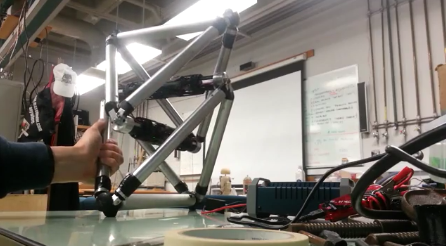A tensegity robot to clean and explore ducts

Researchers in the UCSD Robotics lab have developed a duct-exploring robot based on the principles of tensegrity, a structural design paradigm which combines components under pure tension and pure compression to make mass efficient, accurately controllable structures.
Ph.D. student Jeffrey Friesen talked about the robot in an interview with the communications team at the Jacobs School of Engineering here at the University of California, San Diego. (See video). He works with mechanical engineering professor Thomas Bewley, one of the lead robotics researchers here at the Jacobs School.
The robot was selected to be the iconic image for the upcoming Contextual Robotics Forum on Oct. 30 at UC San Diego.
"One really exciting thing about being here is that there is a big administrative push to get new faculty in robotics," Friesen said. "As the years progress, it's only going to get better. There is going to be a lot of innovative research coming out of this university."
Tensegrity robots have the advantage of being light and flexible. DucTT is built from rigid aluminum tubes and space-age cables that keep its structure together. Researchers chose aluminum over 3D-printed materials to make the robot more resilient.
Tensegrity robots have the advantage of being light and flexible. DucTT is built from lightweight tubes and cables arranged to provide an extensive range of motion with a small number of actuators. The batteries, electronics, motors (actuators), and strain gauges (sensors) are all embedded within the tubes of the structure to shield them from the gas or liquid that may be flowing within the duct during the inspection.
DucTT moves in an inchworm-like fashion along the length of ducts or tubes in any orientation, and can accurately negotiate the intersection of two or more ducts in a controlled, deliberate fashion. Much of the volume of the bars is devoted to the batteries themselves, and thus DucTT can run for up to six hours continuously, untethered, on a single charge.
Duct cleaning robots are a crucial tool to ensure air quality. The World Health Organization estimates that Americans spend 90 percent of their time indoors. Indoor air has inherently a higher concentration of pollutants than outdoor air and 30 percent of U.S. buildings experience air quality problems. Also, the Environmental Protection Agency estimates that indoor air problems cost U.S. businesses $60 billion annually.
In commercial settings, air conditioning and heating systems are the lead contributors to these air quality problems. People working in buildings where these systems have never been cleaned are 60 percent more likely to experience respiratory problems.
Current unmanned systems designed to clean ducts are limited to small, remote-controlled vehicles with brushes, like miniature street sweepers. Such systems are unable to access the remote parts of air conditioning and heating systems; DucTT was designed specifically to address this need.
More information: DuCTT: A tensegrity robot for exploring duct systems. 2014, IEEE International Conference on Robotics and Automation (ICRA) DOI: 10.1109/ICRA.2014.6907473
Provided by University of California - San Diego





















